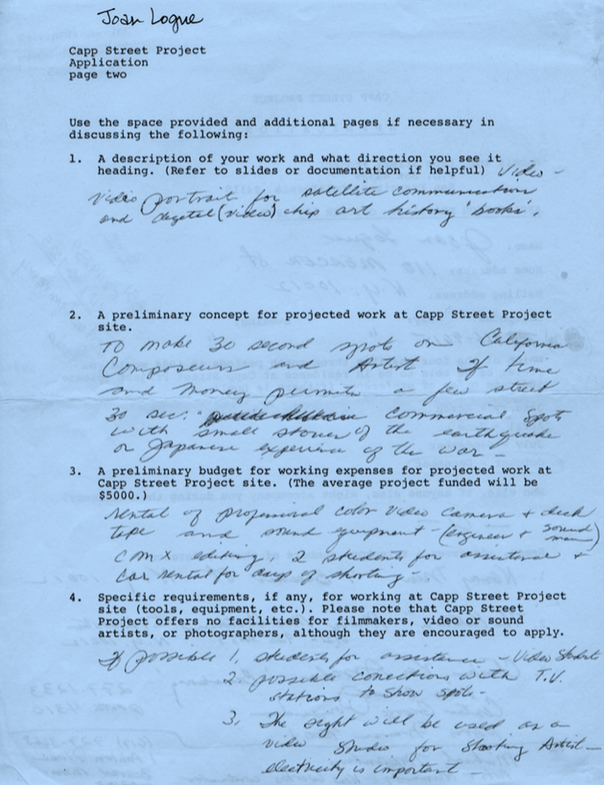Joan Logue is a pioneer in the field of video portraiture. She first learned to use the medium soon after it became available to artists with Sony's introduction of the video portapac in the late sixties. As a still portrait photographer, Logue immediately recognized the new medium's potential for expressing more fully the complexity of the sitter. Although Logue's background was not in film (she studied painting and photography), early on she discovered that video expanded painting and still photography, taking the ‘instant’ out of portraiture to give it a presence in real-time. For this reason, she is recognized as the "originator" of the first video portrait in 1971. There, by using real time and silence to expose the sitter’s presence, she allowed the viewer to observe a person in contemplation and silence.
Since 1971, Joan Logue has completed hundreds of video portraits for installations. In 1979, she developed another form of portraiture called 30 Second Portraits (Spots). Both styles of her portraiture include artists, families, lovers, fisherman, writers, poets, philosophers, composers, street people and auto portraits. Her works have been seen in America and abroad in installations that Logue calls video portrait galleries. They include portraits of Jasper Johns, Willem DeKooning, Robert Rauschenberg, Roy Lichtenstein, Ellsworth Kelly, John Cage, Richard Diebenkorn, Joan Mitchell, Vija Celmins, Judy Chicago, Anna Halprin, Lucinda Childs, Julia Kristeva, Jacques Derrida, Pierre Boulez, Rosa Parks, and Cesar Chavez to name only a few.
Joan Logue currently resides in New York, but originally lived and worked in Los Angeles until 1977. There, she became the first photographic portrait artist at the American Film Institute (1969), and pioneered the first video program at the American Film Institute. As a resident of California, she also taught at the California Institute of the Arts (1971-74), the University of California Los Angeles (1975), and the Otis Art Institute (1976).
After moving to New York in 1977, Logue expanded her scope, receiving a series of grants from the National Endowment for the Arts (1976, 1978, 1982, 1983, 1989) as well as grants from the French Ministry of Culture (1983, 1985, 1991, 1992) which enabled her to create two Paris series plus The Portrait of a Young Girl within a 3d frame and an Auto Portrait 1983-1993. She also received grants from the CAPP Street Project (1984), the Massachusetts Council on the Arts (1985,1988), the New York State Council on the Arts (1982,1989), the New York Cultural Assistance Program (CAP) grant (1978,1982), the Deutscher Akademischer Austausch Dienst (DAAD) Fellowship (1986), the Pew Charitable Trust grant (1999), and a Guggenheim Fellowship (1998). Simultaneously, she began to widen the breadth of her teaching career, holding a variety of international positions at the L'école nationale supérieure d'art de Nancy (1991), L’ecole supérieure des arts décoratifs de Strasbourg (1992), L'école des Beaux-Arts de Bordeaux (1993) and the Massachusetts Institute of Technology (1996). She also held portraiture artist in residence fellowships at the American Center in Paris (1982,1983), the Centres d’Art Contemporain de Montbeliard, Montbeliard (1982), the Centres d’Art Contemporain de Montpellier, Montpellier, France (1983), and Belo Horizonte, Brazil (1989).
Joan Logue has exhibited her video portraits at the San Francisco State Art Gallery, San Francisco, CA: Women in a Polygamous Society 1976; NYC Avant‐garde Film Festival; New York NY, Selected Video Works 1976; Museum of Modern Art NY, California Portraits 1977; Holly Solomon Gallery, New York NY, Installation Video Portraits; California Series, 1978: Corcoran Gallery of Art, 36th Biennale, Washington DC, Video Portraits Gallery: Rauschenberg, Johns, DeKooning, Kelly and Lichtenstein 1979; Long Beach Museum of Art, California, Video Portrait Installation: Alvarez Bravo 1980; Whitney Museum of Art Downtown New York NY, Installation: Video Portrait Robert Rauschenberg 1980; Walker Art Center, Minneapolis, MN, Video Portraits John Cage, Willem DeKooning, 1980; Centre George Pompidou Paris, France, 5 Video Portraits Installation 1983; Venice Biennale, Venice, Italy, 30 Second Spots: New York Artist, 1984; Documenta 8, Kassel, Germany, 30 Second Spots: New York Artist, 1987; Museum of Contemporary Art Kawasaki Japan, New York 30 Second Spots 1988; International Center of Photography, New York, NY, Video Portrait Gallery installation: Rosa Parks, 1991; Musée d'art Contemporain de Nice, Nice, France, Auto Portrait, and The Portrait of a Young Girl 1992; Videoformes Gallery, Clairmont Ferrand, France, Interactive Video Portrait Gallery: Cage, Rauschenberg, Johns and DeKooning 1994; M.I.T., Cambridge MA, ID/entity: Portraits in the 21st Century, Digital Lemmings’: The Video Pin 2001; Museuo Nacional Centro de Arte Reina Sofia Madrid, Spain, Video Portrait Nam June Paik 2006; Shang Elements Museum of Contemporary Art, Beijing, China, Wall Street Traitors 2009; and Centre de Cultura Contemporània de Barcelona, Barcelona Spain, 30 Second Portraits, 2010, Newcomb Art Gallery at Tulane University, New Orleans, Video Portrait: Joan Mitchell 1979, 2010.





